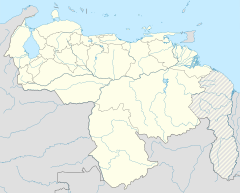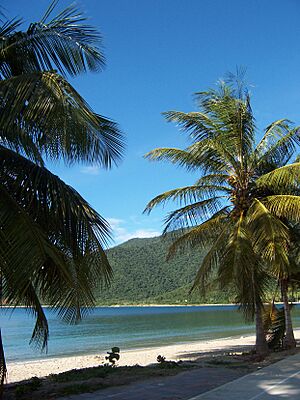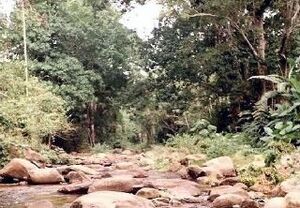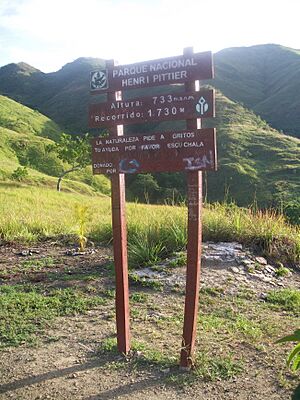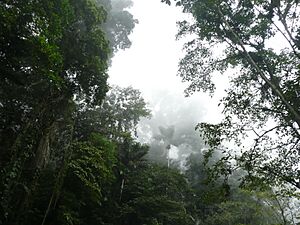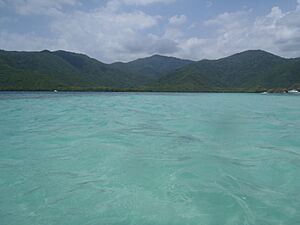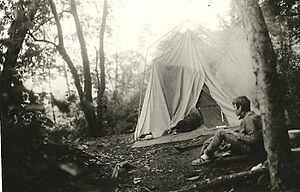Henri Pittier National Park facts for kids
Quick facts for kids Henri Pittier National Park |
|
|---|---|
|
IUCN Category II (National Park)
|
|
 |
|
| Nearest city | Maracay |
| Area | 1078 km² |
| Established | 13 February 1937 |
| Governing body | INPARQUES |
Henri Pittier National Park is the oldest national park in Venezuela. It was created in 1937 and first called Rancho Grande. Later, in 1953, it was renamed to honor Henri Pittier. He was a famous Swiss geographer and botanist who studied plants and animals in Venezuela for many years. He even classified over 30,000 plants in the country!
This park is very special because it was the first national park in Venezuela. It covers 107,800 hectares, which is a huge area. You can find it in the northern part of Aragua state, and it also touches the mountainous area of Carabobo state. It's the biggest national park in the Venezuelan Coastal Range.
The park has two main parts: a steep mountain area and a beautiful coastal area. The mountains are home to over 500 different kinds of birds, including 22 species found nowhere else in the world. The coast has amazing bays, beaches, and resorts that are great for tourists.
Henri Pittier National Park is full of different plants and animals. It's known as an Important Bird Area because so many birds live or pass through here. It's also a special place for protecting species that are close to disappearing.
The park has nine major rivers, which provide important water for nearby cities and towns. Some of the world's best cacao (used to make chocolate!) is grown here, especially in the village of Chuao.
Contents
Park History and Purpose
Henri Pittier National Park was officially created on February 13, 1937. It was first named Rancho Grande by President Eleazar López Contreras. This made it the very first national park in Venezuela.
On May 24, 1953, the park was renamed Henri Pittier. This was to honor Henri Pittier, a Swiss scientist who helped create Venezuela's national park system. He spent much of his life studying the park's tropical forests and its many plants and animals.
When it was first created, the park was about 90,000 hectares. In 1974, during the government of Carlos Andrés Pérez, another 17,800 hectares were added. This brought the park to its current size of 107,800 hectares.
The park was created to protect its amazing cloud forests and coastal areas. These areas were in danger from fires and farming. The park helps protect its many different plants and animals, especially those that are rare or endangered. It also keeps important water sources safe for nearby communities. The park is a great place for research, fun activities, and learning about nature.
Today, the park is protected by the Instituto Nacional de Parques de Venezuela (INPARQUES). They work hard to keep the park's natural resources safe and sound.
Amazing Plant Life
The park has many different types of plants because it has so many different environments. In the lower areas, you might see dwarf trees like Curatella americana and Bowdichia virgilioides. In the cloud forests, you'll find tall trees like the bucket or child tree (Gyranthera caribensis). You can also spot different kinds of palms, such as Bactris setulosa and Chamaedorea pinnatifrons.
Many plants in the park grow on other plants. These are called epiphytes. They include beautiful orchids, bromeliads, and aroids. The park's plant life changes a lot from the highest mountains down to the valleys. You can find tall trees, climbing plants, medium-sized shrubs, herbs, and tiny mosses, lichens, ferns, and fungi.
Water Sources and Rivers
Many rivers flow through Henri Pittier National Park. Rivers like San Miguel, Turiamo, Ocumare, Cata, Cuyagua, Aroa, Cepe, Choroní, and Chuao all flow into the Caribbean Sea. Other rivers, such as Guayabita, Colorado, Güey, and Limón, flow into the Lake of Valencia.
The park also has several fun areas to visit. These include La Guamita, Las Cocuizas, La Trilla, and El Polvorín. You can also see the Birds Pass of Portachuelo, a museum at the Uraca Hydroelectric Plant, and the Santa María Hacienda. There are also great viewpoints along the main roads from Maracay to Choroní and Maracay to Ocumare de la Costa.
Places to Explore
One of the biggest reasons people visit this park is its amazing beaches. Some beaches are easy to reach by car, and these are often very popular. Other beaches can only be reached by boat. These are usually quieter and cleaner. Some of the most visited beaches include Bahía de Cata, Cuyagua, Playa Grande, El Playón, and Playa Chuao. Cuyagua beach is especially famous for surfing in Venezuela!
Another huge draw for the park is its incredible bird population. Over 500 species of birds live here, which is more than 40% of all bird species in Venezuela! Scientists and tourists from all over the world come to the park just to see these birds. A group called the Sociedad Científica Amigos del Parque Nacional Henri Pittier (SCAPNHP) was created in 1989 to help study and protect the park's plants and animals.
You can also visit a zoological museum at the Estación Biológica Rancho Grande. This museum has many of the animal species found in the area. You need to make an appointment to visit. If you take the road to Choroní, you can visit mountain peaks like La Mesa, Palmarito, La Negra, La Negrita, and El Cenizo.
Park Geography
Where is the Park Located?
Henri Pittier National Park is in the Central Region of Venezuela. It covers most of northern Aragua state and a lot of northeastern Carabobo state. It's part of the Venezuelan Coastal Range. The park is close to towns like Choroní, Cuyagua, Chuao, Cata, La Ciénaga, Ocumare de la Costa, and Turiamo.
The easiest ways to get to the park are by road from Maracay. You can take the road to El Limón, which goes through Rancho Grande and down to Ocumare de la Costa. Or you can take the road from Maracay to Las Delicias, which leads to Choroní. There are also buses from the Maracay Bus Terminal that go to Choroní.
Mountains and Land
The park is in the Venezuelan Coastal Range, so it has very rugged land with steep slopes. It starts at sea level and goes up to 2,346 meters high at its highest point, Pico Cenizo.
The park's mountains are mostly made of metamorphic igneous rock. One special feature is the Paso de Portachuelo, a mountain pass at 1,136 meters. This pass is like a highway for many birds, bats, and insects, especially those migrating from the northern hemisphere.
Park Climate
The climate in Henri Pittier Park changes a lot because of its varied height. The park goes from sea level up to 2,436 meters at Pico El Cenizo. In the coastal areas, the average temperature is about 28°C, and it can get hotter than 30°C. In the higher mountain areas, temperatures can drop to 12°C or even 6°C. The park gets a lot of rain during the rainy season, which is from April to November.
Wildlife and Ecosystems
Amazing Biodiversity
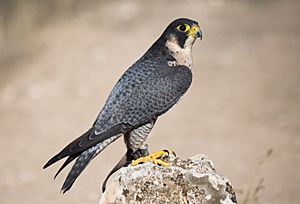
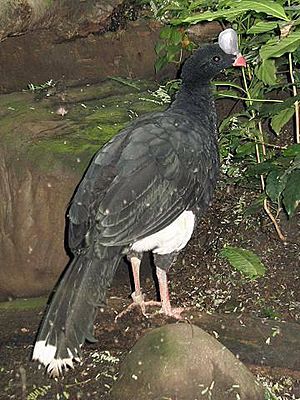
Henri Pittier National Park has an incredible variety of life. It's part of the "hotspot" of the Tropical Andes, which means it's one of the most biodiverse places on Earth. In just a small area of the cloud forest, scientists have found up to 150 different kinds of trees! The "niño" or cucharón tree is one of the most common, growing up to 40 meters tall.
The park is home to about 140 species of mammals, 580 species of birds, 97 species of reptiles, and 38 species of amphibians. It's believed that there are over a million species of insects here! Some endangered animals include the northern spider monkey, the helmeted curassow, and the American crocodile. Famous animals in the park include the sorocuá bird, the harpy eagle, pumas, jaguars, and howler monkeys.
The Dr. Alberto Fernández Yépez Biological Station, run by the Central University of Venezuela, is located in the Rancho Grande area. Since the 1940s, this station has supported studies of the park's plants, animals, and other natural resources. Researchers from all over the world visit to study the amazing life in the cloud forests. The Audubon Society of Venezuela has been studying bird migration through the Portachuelo Pass for over 10 years. Students also use the station to learn about zoology, botany, and geography.
Threats to the Park
Sadly, Henri Pittier National Park is currently facing threats. The biggest problems are fires, whether they are natural forest fires or caused by people. People also sometimes build homes or farms in the park, which destroys forest areas. Hunting animals too much, visitors leaving trash, and not enough maintenance for park facilities also harm the park.
Animal Species and Life Cycle
The park is home to at least 582 species of birds. This means about 43% of all bird species in Venezuela live here, and 6% of all bird species in the world! This is one of the highest bird densities anywhere. The Paso Portachuelo is a very important place for over 79 species of migratory birds that come from the northern hemisphere.
Some of the most well-known birds include the peregrine falcon, the harpy eagle, the helmeted curassow, and the siskin.
There are also 140 species of mammals in the park, which is 47% of all mammal species in Venezuela. The largest groups are bats, followed by rodents and carnivores. You might find tapirs, sloths, anteaters, howler monkeys, ocelots, pumas, and tailed deer.
For reptiles, 97 species have been recorded, and 38 species of amphibians. These include the american crocodile near the San Miguel river, sea turtles, rattlesnakes, and many kinds of toads and frogs.
It's thought that over a million species of insects live in the park, but no one has counted them all yet!
Endangered Species in the Park
Sadly, the numbers of many animals in the park have gone down in recent years. Some are even close to disappearing forever.
Scientists have put the threatened species into three levels of risk:
- Lower Level of Risk: The puma is considered "Near Threatened" globally.
- Vulnerable: This level includes animals like the jaguar, the tapir, and the military macaw.
- Endangered: This is the highest risk level. It includes the northern spider monkey, the helmeted curassow, the american alligator, and the white turtle.
Fun Activities and Attractions

The Paseo del Pargo is a path that goes west through the park's largest mountains, leading up to Pico La Mesa. At the Estación Biológica de Rancho Grande, there's a biological museum with a collection of animals that live in the park.
But the biggest attraction of the park is its beautiful beaches! Some beaches are easy to reach by car. Others are more isolated and quiet, and you can only get to them by boat. Some of the most popular beaches for tourists are:
- Bahía de Cata: Known for its clear, calm waters.
- Cuyagua beach: Perfect for extreme sports like surfing, bodyboarding, and windsurfing.
- La Ciénaga: Has calm, flat waters with corals, great for diving, snorkeling, and kayaking.
- Choroni beach and El Playón: Other popular beaches.
The mountainous part of the park is an excellent place for bird watching. About 6.5% of the world's birds live here, along with many unique species found only in Henri Pittier.
Since the park is a protected area managed by INPARQUES, there are no hotels inside the park itself. However, you can find many cottages and tourist lodges in the nearby towns of Choroní, Cata, Cuyagua, and Ocumare de la Costa. If you want to go camping, you need to get permission from INPARQUES first.
See also
 In Spanish: Parque nacional Henri Pittier para niños
In Spanish: Parque nacional Henri Pittier para niños


